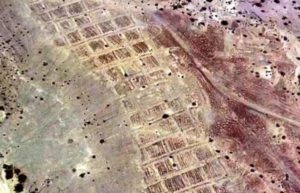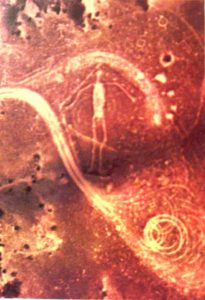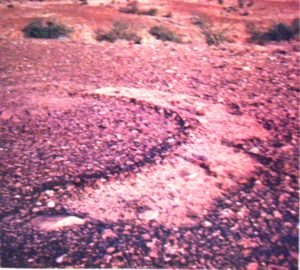Podcast: Play in new window | Download
Subscribe: Apple Podcasts | RSS
 Even those who are not interested in ancient mysteries are familiar with the Nazca Lines in Peru, the gigantic geoglyphs, or earth drawings, etched into the surface of the desert in the southern part of the country. The drawings in Nazca cover a total of 170 square miles with the largest geoglyph being 1,200 feet long. Among the earth pictures are many geometric shapes, some images of trees and flowers, and some 70 drawings of animals. Some of the famous ones known worldwide are of hummingbirds, jaguars, monkeys and llamas. Human figures are also found. The Nazca geoglyphs were made by removing rocks and pebbles from the desert pavement and revealing the lighter-colored soil beneath. The harsh, rainless environment of the southern Peruvian deserts has preserved these gigantic ancient works of art. Mainstream archaeologists believe that the Nazca lines date back to 500 BC and were produced intermittently across a period of 1,000 years. They are attributed to the Nazca Culture although theorists and researchers who do not subscribe to the mainstream view attribute these drawings to other more ancient cultures or even “Ancient Astronauts.” The belief in an off-world origin of these images comes from the idea that most of these huge geoglyphs can only be seen by air. While the world’s attention has turned to this remote part of the South American deserts and people marvel at this huge gallery of outdoor art, few know that Mexico has its own version of the Nazca lines located in the remote deserts of the northern Mexican state of Baja California, just east of Tijuana and just south of Mexico’s border with the United States. The area nicknamed the “Mexican Nazca” is called Macahui.
Even those who are not interested in ancient mysteries are familiar with the Nazca Lines in Peru, the gigantic geoglyphs, or earth drawings, etched into the surface of the desert in the southern part of the country. The drawings in Nazca cover a total of 170 square miles with the largest geoglyph being 1,200 feet long. Among the earth pictures are many geometric shapes, some images of trees and flowers, and some 70 drawings of animals. Some of the famous ones known worldwide are of hummingbirds, jaguars, monkeys and llamas. Human figures are also found. The Nazca geoglyphs were made by removing rocks and pebbles from the desert pavement and revealing the lighter-colored soil beneath. The harsh, rainless environment of the southern Peruvian deserts has preserved these gigantic ancient works of art. Mainstream archaeologists believe that the Nazca lines date back to 500 BC and were produced intermittently across a period of 1,000 years. They are attributed to the Nazca Culture although theorists and researchers who do not subscribe to the mainstream view attribute these drawings to other more ancient cultures or even “Ancient Astronauts.” The belief in an off-world origin of these images comes from the idea that most of these huge geoglyphs can only be seen by air. While the world’s attention has turned to this remote part of the South American deserts and people marvel at this huge gallery of outdoor art, few know that Mexico has its own version of the Nazca lines located in the remote deserts of the northern Mexican state of Baja California, just east of Tijuana and just south of Mexico’s border with the United States. The area nicknamed the “Mexican Nazca” is called Macahui.
 American archaeologist Malcolm Rogers was the first to describe in detail the mysterious rock features in the deserts between Tijuana and Mexicali in an article he published in 1939. He initially called the round geoglyphs “sleeping circles” because he was using early Jesuit accounts in southern Baja of Native Americans who used rock-lined features to delineate habitations. The area now known as Macahui contained more than just circular rock formations scraped away from the desert floor, though, and many formations were associated with trails and other artifacts, so Rogers moved away from his “sleeping circles” or habitation hypothesis and theorized that more was going on in this area. He attributed the geoglyphs to what he described as the San Dieguito Complex, an ancient Native American culture that existed on both sides of the US-Mexico border, starting at around 8200 BC. These unusual geometric circles, lines and pictures etched into the desert pavement did not get much notice outside of academic circles for many years. Scholars debated whether they were made more recently or even if some of them could have been made naturally, by forces of wind and rain. Macahui gained greater attention in the late 1970s when the Chief of Communications for the state government of Baja California, a man named Fernando Rodríguez, stumbled on some interesting configurations on the desert floor on foot when he was exploring an area about 25 kilometers west of the state capital of Mexicali. Rodríguez teamed up with a college professor named Alberto Aguilar and they chartered a plane to view the region by air. They were amazed at what they saw from the plane. They christened the area “Macahui” which is a combination of the names of two intermittent lakes located north and south of the area, Laguna Macuata, also known as Laguna Salada on some maps, and Laguna Cahuilla.
American archaeologist Malcolm Rogers was the first to describe in detail the mysterious rock features in the deserts between Tijuana and Mexicali in an article he published in 1939. He initially called the round geoglyphs “sleeping circles” because he was using early Jesuit accounts in southern Baja of Native Americans who used rock-lined features to delineate habitations. The area now known as Macahui contained more than just circular rock formations scraped away from the desert floor, though, and many formations were associated with trails and other artifacts, so Rogers moved away from his “sleeping circles” or habitation hypothesis and theorized that more was going on in this area. He attributed the geoglyphs to what he described as the San Dieguito Complex, an ancient Native American culture that existed on both sides of the US-Mexico border, starting at around 8200 BC. These unusual geometric circles, lines and pictures etched into the desert pavement did not get much notice outside of academic circles for many years. Scholars debated whether they were made more recently or even if some of them could have been made naturally, by forces of wind and rain. Macahui gained greater attention in the late 1970s when the Chief of Communications for the state government of Baja California, a man named Fernando Rodríguez, stumbled on some interesting configurations on the desert floor on foot when he was exploring an area about 25 kilometers west of the state capital of Mexicali. Rodríguez teamed up with a college professor named Alberto Aguilar and they chartered a plane to view the region by air. They were amazed at what they saw from the plane. They christened the area “Macahui” which is a combination of the names of two intermittent lakes located north and south of the area, Laguna Macuata, also known as Laguna Salada on some maps, and Laguna Cahuilla.  Rodríguez and Aguilar made a short film in 1980 called “Macahui” showing the site from the air for the very first time. The film generated mild curiosity throughout Mexico and many newspapers at the time went wild with speculation about Macahui. One article had claimed that the features on the desert floor were over 20,000 years old while one used Rogers’ “sleeping circles” habitation hypothesis and stated that Macahui was probably the largest town ever to have existed in the ancient world. Of course, there was immediate speculation about a connection to the ancient Nazca lines in Peru and even some theories about assistance from extraterrestrials. Was Macahui an alien SOS for humans or was it part of an ancient landing site for off-world visitors? The Rodríguez and Aguilar film titled “Macahui” was presented at the annual meetings of the Southwestern Anthropological Association and the Society for California Archaeology in 1980 and attending members suggested that the shapes and lines in the desert were the result of modern rather than ancient activity. What happened next is what often occurs in Mexico when an archaeological site becomes known to a wider public: The National Institute of Anthropology and History in Mexico City, or the INAH, sent two archaeological researchers, Julio Montané Marti and Angel Jesús Ochoa Zazueta, to make further assessments of the region. The report generated by Montané and Ochoa described the mysterious lines, circles, rhombuses, rectangles, trapezoids, half moons and the lone figures of a human, a whale and a monkey. As their investigation was preliminary, the archaeologists could not come to any conclusions about dates, or who made these designs, or why this gigantic outdoor art gallery even exists.
Rodríguez and Aguilar made a short film in 1980 called “Macahui” showing the site from the air for the very first time. The film generated mild curiosity throughout Mexico and many newspapers at the time went wild with speculation about Macahui. One article had claimed that the features on the desert floor were over 20,000 years old while one used Rogers’ “sleeping circles” habitation hypothesis and stated that Macahui was probably the largest town ever to have existed in the ancient world. Of course, there was immediate speculation about a connection to the ancient Nazca lines in Peru and even some theories about assistance from extraterrestrials. Was Macahui an alien SOS for humans or was it part of an ancient landing site for off-world visitors? The Rodríguez and Aguilar film titled “Macahui” was presented at the annual meetings of the Southwestern Anthropological Association and the Society for California Archaeology in 1980 and attending members suggested that the shapes and lines in the desert were the result of modern rather than ancient activity. What happened next is what often occurs in Mexico when an archaeological site becomes known to a wider public: The National Institute of Anthropology and History in Mexico City, or the INAH, sent two archaeological researchers, Julio Montané Marti and Angel Jesús Ochoa Zazueta, to make further assessments of the region. The report generated by Montané and Ochoa described the mysterious lines, circles, rhombuses, rectangles, trapezoids, half moons and the lone figures of a human, a whale and a monkey. As their investigation was preliminary, the archaeologists could not come to any conclusions about dates, or who made these designs, or why this gigantic outdoor art gallery even exists.
In a 1982 article in the Mexican publication México Desconocido, or in English, “Unknown Mexico,” Alberto Aguilar teamed up with an investigator named Harry Moller to delve further into the Macahui mystery. Their article was called “El Enigma de Macahui,” or in English, “The Macahui Enigma,” and in it the authors theorized that the area was either a large ceremonial site or a massive ancient cemetery. The piece was criticized by scholars for not being based on serious or scientifically-based archaeology, and this prompted further investigation out of Mexico City. The National Museum of Anthropology and History wanted to solve the enigma of Macahui once and for all and sponsored an expedition. Representing the INAH from Mexico City was Julia Bendímez. She was joined by Héctor León from the Regional Museum at the Autonomous University of Baja California in Mexicali, and Don Laylander of the Cultural Resource Management Center at San Diego State University on the other side of the border. The team conducted intensive field research at Macahui and published their findings in a 1986 article called, “Macahui: The Unmaking of an Enigma” in The Journal of California and Great Basin Anthropology. In the abstract of the article, the authors state:
 “In our investigation of Macahui, evidence on the function of the clearings was considered. Several types of evidence were evaluated, including the patterns of the clearings’ occurrence, their associations, their morphology, the characteristics of the pavement immediately around them, and the testimony of the region’s contemporary inhabitants. This evidence was used to evaluate three hypotheses: (1) that the clearings were made for prehistoric habitation, (2) that they were made as geoglyphs, and (3) that they were byproducts of modern gravel collection.”
“In our investigation of Macahui, evidence on the function of the clearings was considered. Several types of evidence were evaluated, including the patterns of the clearings’ occurrence, their associations, their morphology, the characteristics of the pavement immediately around them, and the testimony of the region’s contemporary inhabitants. This evidence was used to evaluate three hypotheses: (1) that the clearings were made for prehistoric habitation, (2) that they were made as geoglyphs, and (3) that they were byproducts of modern gravel collection.”
The article written by Bendímez, León and Laylander is as academic as academic can be, detailing the tedious method of rock counting and other archaeological methods used to perform their scientific analyses. Their investigation included interviews with locals from the town of La Rumorosa about 30 kilometers west of Macahui. The people interviewed confirmed that large-scale gravel collecting occurred in the region in the early 1960s. The technique used was to rake gravel into circular piles and cart it off in trucks, thus leaving behind a bare circular area on the desert floor. Here is the conclusion of the article written about the “official” scientific expedition to Macahui:
“In sum, we believe that the available evidence is sufficient to refute the claims made for Macahui as a major prehistoric site. That geoglyphs were produced aboriginally in the general region of northern Baja California and southern California by the clearing of desert pavement surfaces is not disputed. That other clearings were made as habitation areas, “sleeping circles” in temporary camps, also seems highly likely. Some aboriginal features of either or both of these types may be present specifically in the Macahui area, although this is not yet confirmed. We recommend in particular the techniques of detailed morphological examination and controlled study of the surrounding pavement as methods for distinguishing such features from the traces of modern commercial gravel collection.”
So, in short, the formal archaeological study meant to answer the questions about this mysterious place did not come up with too many concrete conclusions, and even suggested further investigation. The title of the article, “The Unmaking of an Enigma,” is not entirely accurate because even by the scholars’ own admission there is a lot that is still unknown about the area. The article failed to investigate the larger drawings of specific artistic forms, like the whale, for example, that could not be explained away by mere gravel collection.
 Is there more to this mysterious place? On October 12th, 2018 Mexican paranormal researcher and broadcaster Yohanan Díaz Vargas interviewed members of a Mexicali-based UFO and paranormal research group called Grupo Orion. Speaking for the group, Orion member Raul Pinero described an instance that happened at around midnight near the Cerro de Centinela in the Macahui Zone. Pinero was there with several others to watch the skies for UFOs, as this area is not only known by locals for its strange terrestrial art but for its strange anomalies in the skies. While sitting around watching for UFOs a strange being passed by the group going at a very rapid pace, as if it were riding a bicycle. Pinero described it in the Díaz Vargas interview as being slender and humanoid, somewhere from 8 to 9 feet tall, gray in color with large white hands. While it seemed like it was riding a bicycle because of its speed, it wasn’t, but rather it had a large, quick stride. The being passed the group in about 8 or 9 seconds and was about 30 yards away from them. The Grupo Orion plans to return to Macahui with sophisticated camera and sound equipment. So, lights in the sky and unexplained creatures can be added to the list of unusual things found in this remote and seemingly insignificant patch of Mexico’s northern deserts. It’s apparent that the enigma of Macahui was never “unmade” but continues to the present day.
Is there more to this mysterious place? On October 12th, 2018 Mexican paranormal researcher and broadcaster Yohanan Díaz Vargas interviewed members of a Mexicali-based UFO and paranormal research group called Grupo Orion. Speaking for the group, Orion member Raul Pinero described an instance that happened at around midnight near the Cerro de Centinela in the Macahui Zone. Pinero was there with several others to watch the skies for UFOs, as this area is not only known by locals for its strange terrestrial art but for its strange anomalies in the skies. While sitting around watching for UFOs a strange being passed by the group going at a very rapid pace, as if it were riding a bicycle. Pinero described it in the Díaz Vargas interview as being slender and humanoid, somewhere from 8 to 9 feet tall, gray in color with large white hands. While it seemed like it was riding a bicycle because of its speed, it wasn’t, but rather it had a large, quick stride. The being passed the group in about 8 or 9 seconds and was about 30 yards away from them. The Grupo Orion plans to return to Macahui with sophisticated camera and sound equipment. So, lights in the sky and unexplained creatures can be added to the list of unusual things found in this remote and seemingly insignificant patch of Mexico’s northern deserts. It’s apparent that the enigma of Macahui was never “unmade” but continues to the present day.
REFERENCES
Rogers, Malcolm J. (1929). “The Stone Art of the San Dieguito Plateau”. American Anthropologist. 31 (3): 454–467
